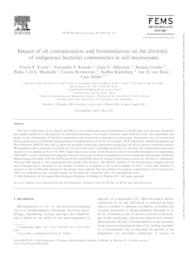Impact of oil contamination and biostimulation on the diversity of indigenous bacterial communities in soil microcosms.
Impact of oil contamination and biostimulation on the diversity of indigenous bacterial communities in soil microcosms.
Autoria: EVANS, F. F.; ROSADO, A. S.; SEBASTIÁN, G. V.; CASELLA, R.; MACHADO, P. L. O. de A.; HOLMSTRÖM, C.; KJELLEBERG, S.; ELSAS, J. D. van; SELDIN, L.
Resumo: The aim of this study was to analyse the effect of oil contamination and biostimulation (soil pH raise, and nitrogen, phosphate and sulphur addition) on the diversity of a bacterial community of an acidic Cambisol under Atlantic Forest. The experiment was based on the enumeration of bacterial populations and hydrocarbon degraders in microcosms through the use of conventional plating techniques and molecular fingerprinting of samples directly from the environment. PCR followed by denaturing gradient gel electrophoresis (DGGE) was used to generate microbial community fingerprints employing 16S rRNA gene as molecular marker. Biostimulation led to increases of soil pH (to 7.0) and of the levels of phosphorus and K, Ca, and Mg. Oil contamination caused an increase in soil organic carbon (170-190% higher than control soil). Total bacterial counts were stable throughout the experiment, while MPN counts of hydrocarbon degraders showed an increase in the biostimulated and oil-contaminated soil samples. Molecular fingerprinting performed with 16S rRNA gene PCR and DGGE analysis revealed stable patterns along the 360 days of experiment, showing little change in oil-contaminated microcosms after 90 days. The DGGE patterns of the biostimulated samples showed severe changes due to decreases in the number of bands as compared to the control samples as from 15 days after addition of nutrients to the soil. Results obtained in the present study indicate that the addition of inorganic compounds to soil in conjunction with oil contamination has a greater impact on the bacterial community than oil contamination only.
Ano de publicação: 2004
Tipo de publicação: Artigo de periódico
Unidade: Embrapa Solos
Palavras-chave: 16S rRNA gene, Atlantic forest, Bacterial diversity, Biostimulation, Cambisols, Crude oil, DGGE, Soil microcosms
Observações
1 - Por padrão são exibidas publicações dos últimos 20 anos. Para encontrar publicações mais antigas, configure o filtro ano de publicação, colocando o ano a partir do qual você deseja encontrar publicações. O filtro está na coluna da esquerda na busca acima.
2 - Para ler algumas publicações da Embrapa (apenas as que estão em formato ePub), é necessário ter, no celular ou computador, um desses softwares gratuitos. Sistemas Android: Google Play Livros; IOS: iBooks; Windows e Linux: software Calibre.
Acesse outras publicações
Acesse a Base de Dados da Pesquisa Agropecuária (BDPA) para consultar o acervo completo das bibliotecas da Embrapa.

